Ask questions which are clear, concise and easy to understand.
Ask QuestionPosted by Dgf Chd 5 years, 2 months ago
- 1 answers
Posted by Dgf Chd 5 years, 2 months ago
- 1 answers
Posted by Amol Lende 5 years, 2 months ago
- 1 answers
Gaurav Seth 5 years, 2 months ago
Given an electric dipole placed in a non-uniform electric field. An electric dipole always experiences a torque when placed in uniform as well as non-uniform electric field. But in non-uniform electric field, dipole will also experience net force of attraction. So the electric dipole in non-uniform electric field experiences both torque and force.
Posted by Amol Lende 5 years, 2 months ago
- 1 answers
Gaurav Seth 5 years, 2 months ago
if the body is negatively charged,the charged body's mass will be equal to the original (uncharged body's) mass plus the mass of electron added for charging . if the body is positively charge , the charged body mass will be equal to the original mass minus the mass of electron removed for charging
Posted by Amol Lende 5 years, 2 months ago
- 5 answers
Posted by Dipali Ahirwar 5 years, 2 months ago
- 1 answers
Yogita Ingle 5 years, 2 months ago
Relation between electric field and potential
According to the relation between electric field and potential,
- Electric field is in the direction in which the potential decreases steepest.
- Its magnitude is given by the change in the magnitude of potential per unit displacement normal to the equipotential surface at the point.

Posted by Sumati Yadav 5 years, 2 months ago
- 2 answers
Nidhi Kashyap ☺☺ 5 years, 2 months ago
Gaurav Seth 5 years, 2 months ago
Electric current flowing through a conductor I = n AqVd
where A = cross-sectional area of the conductor, n= number of conduction electrons per unit volume, q is the charge of an electron and Vd is the drift velocity.
Posted by Abhay Yadav 5 years, 2 months ago
- 1 answers
Gaurav Seth 5 years, 2 months ago
Van de Graaff generator is a device used for building up high potential differences of the order of a few million volts.
Principle − It is based on the principle that charge given a hollow conductor is transferred to the outer surface and is distributed uniformly over it.
Construction:
It consists of a large spherical conducting shell (S) supported over the insulating pillars. A long narrow belt of insulating material is wound around two pulleys P1 and P2. B1 and B2 are two sharply pointed metal combs. B1 is called the spray comb and B2 is called the collecting comb.
Working − The spray comb is given a positive potential by a high tension source. The positive charge gets sprayed on the belt.
As the belt moves and reaches the sphere, a negative charge is induced on the sharp ends of the collecting comb B2 and an equal positive charge is induced on the farther end of B2.
This positive charge shifts immediately to the outer surface of S. Due to discharging action of sharp points of B2, the positive charge on the belt is neutralised. The uncharged belt returns downwards and collects the positive charge from B1, which in turn is collected by B2. This process is repeated and the positive charge on S goes on accumulating. In this way, voltage differences of as much as 6 or 8 million volts (with respect to the ground) can be built up
Use: Van de Graaff generator generates high potential differences that are used to accelerate charged particles such as electrons, protons, ions, etc. used for nuclear disintegration.
Limitations: 1) It's a series combination that allows only one route for the movement of charge.
2) It can accelerate only the charged particles not the uncharged particles.
Posted by Abuzar Gour 5 years, 2 months ago
- 2 answers
Yogita Ingle 5 years, 2 months ago
Conductivity of a solution is defined as the conductance of a solution of 1 cm in length and area of cross-section 1 sq. cm. The inverse of resistivity is called conductivity or specific conductance. It is represented by the symbol k. If p is resistivity, then we can write:
k = 1 / p
The conductivity of a solution at any given concentration is the conductance (G) of one unit volume of solution kept between two platinum electrodes with the unit area of cross-section and at a distance of unit length.
Jahnavi Laller 5 years, 2 months ago
Posted by Gursimran Singh 5 years, 2 months ago
- 1 answers
Yogita Ingle 4 years, 6 months ago
When a capacitor is charged by a battery, work is done by the charging battery at the expense of its chemical energy. This work is stored in the capacitor in the form of electrostatic potential energy.
Consider a capacitor of capacitance C. Initial charge on capacitor is zero. Initial potential difference between capacitor plates = zero. Let a charge Q be given to it in small steps. When charge is given to capacitor, the potential difference between its plates increases. Let at any instant when charge on capacitor be q, the potential difference between its plates V=q/C
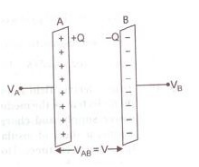
Now work done in giving an additional infinitesimal charge dq to capacitor
dW = V dq = q/C dq
The total work done in giving charge from 0 to Q will be equal to the sum of all such infinitesimal works, which may be obtained by integration. Therefore total work
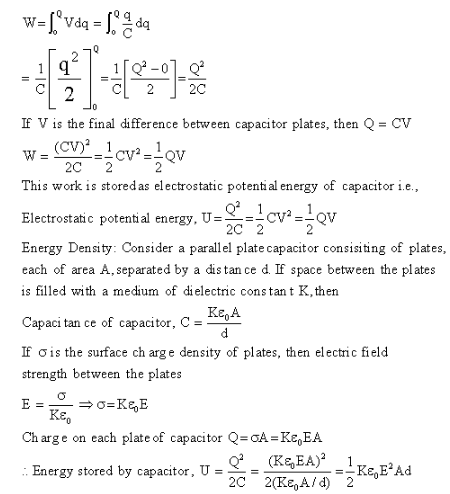
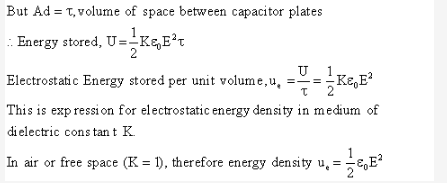
Posted by Himanshi Tripathi 5 years, 2 months ago
- 0 answers
Posted by Subhadeep Mandal 5 years, 2 months ago
- 1 answers
Jahnavi Laller 5 years, 2 months ago
Posted by Sharana Basava 5 years, 2 months ago
- 0 answers
Posted by Suman Kewat 5 years, 2 months ago
- 0 answers
Posted by Akash Yadav 5 years, 2 months ago
- 1 answers
Zalak Desaii 5 years, 2 months ago
Posted by Krishna Singh 5 years, 2 months ago
- 0 answers
Posted by Suraj Prajapat 5 years, 2 months ago
- 0 answers
Posted by Manpreet Rai 5 years, 2 months ago
- 2 answers
Ravi Shankar 5 years, 2 months ago
Gaurav Seth 5 years, 2 months ago
Expression for Impedance in LCR series circuit: Suppose resistance R, inductance L and capacitance C are connected in series and an alternating source of voltage V =V0sinωt is applied across it. (fig. a) On account of being in series, the current (i ) flowing through all of them is the same.
Suppose the voltage across resistance R is VR, voltage across inductance L is VL and voltage across capacitance C is VC. The voltage VR and current i are in the same phase, the voltage VL will lead the current by angle 90° while the voltage VC will lag behind the current by angle 90° (fig. b). Clearly VC and VL are in opposite directions, therefore their resultant potential difference =VC -VL (if VC >VC ). Thus VR and (VC -VL ) are mutually perpendicular and the phase difference between them is 90°. As applied voltage across the circuit is V, the resultant of VR and (VC -VL ) will also be V. From fig.
The phase difference (ϕ) between current and voltage ϕ is given by tanϕ = (XC - XL)/R The graph of variation of peak current im with frequency is shown in fig.
With increase in frequency, current first increases and then decreases. At resonant frequency, the current amplitude is maximum.
Posted by Ashish Kumar 5 years, 2 months ago
- 1 answers
Gaurav Seth 5 years, 2 months ago
Properties
- Electromagnetic waves are propagated by oscillating electric fields and magnetic field oscillation at right angles to each other.
- These waves travel with speed 3×108ms−1 in vacuum.
- They are not deflected by electric or magnetic field.
- They can show interference or diffraction.
- They are transverse waves.
- May be polarized.
- Need no medium of propagation.
Posted by Prabhat Yadav 5 years, 2 months ago
- 1 answers
Tanya ?? 5 years, 2 months ago
Posted by Ankit Kumar 5 years, 2 months ago
- 2 answers
Abhishek -- 5 years, 2 months ago
Suryakant Swain 5 years, 2 months ago
Posted by Priyanshu Kumar 5 years, 2 months ago
- 2 answers
Posted by आर्यन चौबे 5 years, 2 months ago
- 5 answers
Yangzee Sherpa 5 years, 2 months ago
Posted by Aditya Sharma 5 years, 2 months ago
- 3 answers
Preeti Yadav 5 years, 2 months ago
Posted by Krishna Singh 5 years, 2 months ago
- 0 answers
Posted by Mr. Badmash 5 years, 2 months ago
- 2 answers
Mishti ???? 5 years, 2 months ago

myCBSEguide
Trusted by 1 Crore+ Students

Test Generator
Create papers online. It's FREE.

CUET Mock Tests
75,000+ questions to practice only on myCBSEguide app
 myCBSEguide
myCBSEguide
Gaurav Seth 5 years, 2 months ago
Consider a ring of radius 'a' which carries uniformly distributed positive total charge Q.
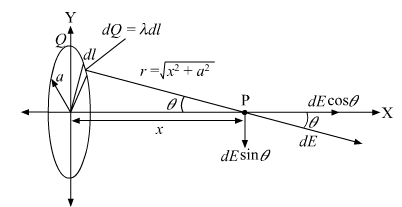
To find: electric field due to a ring at a point P lying at a distance x from its centre along the central axis perpendicular to the plane of the ring.
As the charge is distributed uniformly over the ring, the charge density over the ring is,
The perpendicular component of electric field due to charge on the ring along the x-axis cancels each other out.
As there is same charge on both sides of the ring, the magnitude of the electric field at P due to the segment of charge dQ is given by,
dE = ke

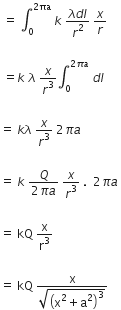
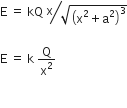
Ex =
1. At the centre (X = 0) , electric field is zero.
2. When x>> a, a can be neglected in the denominator.
Therefore,
1Thank You